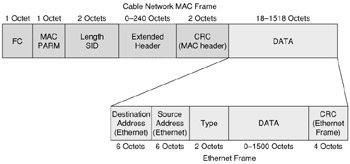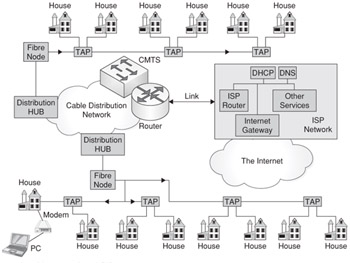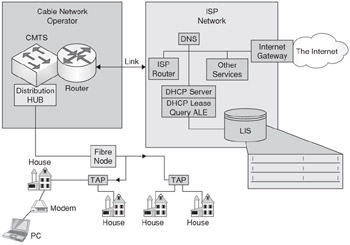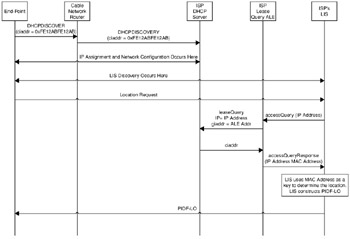Cable Networks
Cable television dates back to the late 1940s and stems from the problem of some areas receiving only weak televisions signals. To counter this, communities established common antennas in good areas of reception and ran cables past households allowing them to obtain a strong clear signal. This scheme was called Community Antenna Television or CATV, a name that is still used today to describe cable television and data deployments. The North American cable industry formed an alliance in 1995 to develop specifications for data over cable networks called Data Over Cable Service Interface Specifications (DOCSIS), and it is these DOCSIS-based networks that are currently the heart of modern cable networks in North America. This section provides a brief overview of cable networks as they relate to DOCSIS-based deployments. The details of framing and network registration, as well as authentication, are not considered.
The Anatomy of Cable Networks
Cable networks have come a long way since the basic concept of a shared antenna. The general principle and architecture of cable networks is that first and foremost they are broadcast networks, with signals being sent from a single headend to a multitude of receivers in people's houses. Data signals in cable networks are carried in channels where each channel is allocated a band of spectrum within the cable's total available bandwidth. Channels in the United States generally have a bandwidth of 6MHz-the basic channel bandwidth adopted into the DOCSIS suite of specifications (see Figure 6.25).

Figure 6.25: A modern cable network configuration.
Originally, all channels in a cable system were for downstream use only; however, the advent of demand for pay-per-view, voice, and data has resulted in cable networks migrating to become two-way systems providing both upward and downward links. In general, end users of data networks consume more data than they produce, consequently cable networks, like their DSL counterparts are asymmetric in nature-that is, far more bandwidth is allocated to the downward channels than the upward channels.
The evolution of cable networks has led to more intelligence being required in the cable headend controller. This is of particular importance for the management of cable modems where optimal use of uplink resources is crucial to overall network performance. The device in the headend is responsible for cable modem management in the Cable Modem Termination System (CMTS). A CMTS supports multiple low bit-rate uplink data channels and a single high-speed downlink data channel. All cable modems listen to the same downlink, and each cable modem is told specifically which uplink channel it may use and when it may use it. Uplink channels are slotted to gain maximum efficiency and sharing of the bandwidth-in other words, the 6MHz representing the available bandwidth is broken into time-slices, and each slice of time is referred to as a slot. Using this technique requires all cable modems to have the same notion of when a slot starts and finishes. Since all cable modems are at different distances from the CMTS, the modems somehow need to be synchronized. This is achieved by the CMTS ranging the modems before allowing them to transmit data packets. Ranging ensures that if any modem is told to transmit in Channel 1 (no matter where a modem is in the cable chain) all modem signals will arrive at the CMTS at the same time.
DOCSIS cable modems have a specific MAC protocol developed to run over the cable RF network. Addresses for this interface are assigned to the cable modem by the CMTS at network attachment time. All data over a cable network is framed inside these MAC messages, this includes management style messages as well as data messages. Data messages are generally sent in the form of Ethernet frames that are packaged inside the data component of a cable MAC message (see Figure 6.26).

Figure 6.26: A cable network MAC frame.
When a cable modem is manufactured, it is assigned a unique IEEE 48-bit Ethernet MAC address by its manufacturer. A cable modem operating as a residential gateway takes data packets from the home network and reframes them with the cable modem's Ethernet address. This Ethernet frame is then encapsulated into a cable network MAC frame and sent to the CMTS. The MAC frame is removed at the CMTS and the resulting Ethernet packet is passed on to the ISP for the cable network.
Cable networks use cabling framing to convey Ethernet packets between the cable modem and the CMTS. The CMTS then conveys Ethernet frames to and from the ISP. The cable network can be thought of as a large distributed switched Ethernet network. Such an environment makes it less easy to support multiple ISPs, as is done in DSL environments, though not impossible. Most cable network operators therefore either run the ISP themselves or provide exclusive access to a dedicated ISP (see Figure 6.27).

Figure 6.27: Cable Internet configuration.
Cable modems are not quite as plug-and-play as their DSL counterparts. A cable modem to some extent requires a degree of registration in the cable network in order to operate correctly. From a pure switching standpoint, the Ethernet address of the modem can generally be learned by the CMTS and other switching devices, but there is a need in cable networks to be able to associate the modem with a user's service to ensure that the correct services are made available. This registration often occurs online through special web pages and other registration mechanisms. Consequently, a direct association between the MAC address, the user, and the user's physical address is formed as part of the service provisioning and registration process.
Location in Cable Networks
The most common way to provide configuration information for the cable modems and hosts inside a cable network is through a combination of DHCP and TFTP. Given the close association between the cable network operator and the ISP, and the previously described modem registration process, an association between MAC address and physical address is possible. Unlike DSL networks that by and large use PPP, cable networks are in a serious position to consider DHCP as a location acquisition option. This choice comes not just because of the use of DHCP, but because of the strong coupling between the cable network operator and the ISP, and the tight control that many cable operators have over the configuration and firmware running in cable modems at customer sites. This control allows the cable operator to automatically update many modems to support the DHCP location options. It does not, however, provide them with a unilateral ability to upgrade all systems, particularly those residing behind a residential firewall. These issues, combined with location dependability and compatibility with other network-based solutions, may cause cable Internet service providers to consider a HELD location acquisition solution in preference to a DHCP-based location acquisition solution.
Location determination in a cable network relies on the tie between the Ethernet MAC address and the physical address of the modem which are bound together at the time of service registration. The DHCP server in a cable network acts much the same as it would in an enterprise or DSL environment, and provides a binding between an IP address and an Ethernet MAC address. The DHCP lease query ALE described in Chapter 5 can be used to provide the binding between IP and Ethernet MAC address to the LIS. The LIS can then use this information to bind the IP address to the physical location of the end-point using the Ethernet MAC address to correlate the two. How this could be deployed in a cable network is shown in Figure 6.28.

Figure 6.28: Cable Internet location configuration.
There are a few things to note with this approach. If the DHCP server is not equipped with an ALE (such as the prototype ALE described in Chapter 5), then the LIS cannot determine location until the end-point makes a request for location. The reason for this is that the DHCP lease query ALE is a reactive element, not active as is the case with the built-in ALE, which can send asynchronous notifications to the LIS. Tying the physical location of the user to the Ethernet MAC address of a cable modem presents problems if the cable modem moves within the same access network-that is, the LIS will associate the cable modem with its originally provided location unless a registration occurs.
The following steps through the diagram shown in Figure 6.29.
-
Cable modem initiates a DHCPDISCOVER that finds its way to the ISP DHCP server.
-
The ISP DHCP server allocates the cable modem an IP address and either provides additional configuration through DHCP options, or it provides the location of a TFTP server from which the cable modem can download configuration data.
-
The end-point learns the location of the LIS from the mechanism described in Chapter 4.
-
The end-point makes a HELD location request to the ISP LIS.
-
The ISP LIS uses the IP address to make a request to the DHCP lease query ALE.
-
The DHCP lease query ALE issues a DHCP lease query to the ISP DHCP server.
-
The DHCP server responds to the lease query with the MAC address of the cable modem to which the requesting end-point is connected.
-
The DHCP lease query ALE takes the response and sends a FLAP access query response message to the ISP LIS.
-
The ISP LIS uses the cable modem's MAC address to key into a database to retrieve the location of the cable modem.
-
The ISP LIS constructs a PIDF-LO and returns this to the end-point.

Figure 6.29: Cable network location acquisition.
EAN: 2147483647
Pages: 129